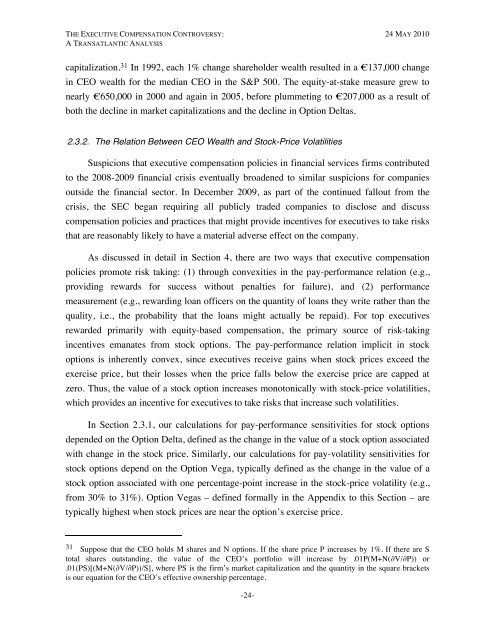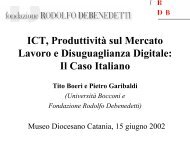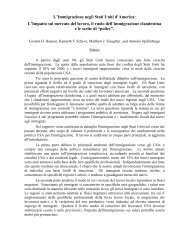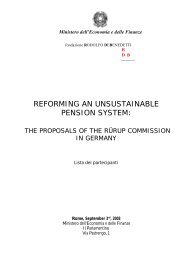The Executive Compensation Controversy - Fondazione Rodolfo ...
The Executive Compensation Controversy - Fondazione Rodolfo ...
The Executive Compensation Controversy - Fondazione Rodolfo ...
You also want an ePaper? Increase the reach of your titles
YUMPU automatically turns print PDFs into web optimized ePapers that Google loves.
THE EXECUTIVE COMPENSATION CONTROVERSY: 24 MAY 2010A TRANSATLANTIC ANALYSIScapitalization. 31 In 1992, each 1% change shareholder wealth resulted in a €137,000 changein CEO wealth for the median CEO in the S&P 500. <strong>The</strong> equity-at-stake measure grew tonearly €650,000 in 2000 and again in 2005, before plummeting to €207,000 as a result ofboth the decline in market capitalizations and the decline in Option Deltas.2.3.2. <strong>The</strong> Relation Between CEO Wealth and Stock-Price VolatilitiesSuspicions that executive compensation policies in financial services firms contributedto the 2008-2009 financial crisis eventually broadened to similar suspicions for companiesoutside the financial sector. In December 2009, as part of the continued fallout from thecrisis, the SEC began requiring all publicly traded companies to disclose and discusscompensation policies and practices that might provide incentives for executives to take risksthat are reasonably likely to have a material adverse effect on the company.As discussed in detail in Section 4, there are two ways that executive compensationpolicies promote risk taking: (1) through convexities in the pay-performance relation (e.g.,providing rewards for success without penalties for failure), and (2) performancemeasurement (e.g., rewarding loan officers on the quantity of loans they write rather than thequality, i.e., the probability that the loans might actually be repaid). For top executivesrewarded primarily with equity-based compensation, the primary source of risk-takingincentives emanates from stock options. <strong>The</strong> pay-performance relation implicit in stockoptions is inherently convex, since executives receive gains when stock prices exceed theexercise price, but their losses when the price falls below the exercise price are capped atzero. Thus, the value of a stock option increases monotonically with stock-price volatilities,which provides an incentive for executives to take risks that increase such volatilities.In Section 2.3.1, our calculations for pay-performance sensitivities for stock optionsdepended on the Option Delta, defined as the change in the value of a stock option associatedwith change in the stock price. Similarly, our calculations for pay-volatility sensitivities forstock options depend on the Option Vega, typically defined as the change in the value of astock option associated with one percentage-point increase in the stock-price volatility (e.g.,from 30% to 31%). Option Vegas – defined formally in the Appendix to this Section – aretypically highest when stock prices are near the option’s exercise price.31 Suppose that the CEO holds M shares and N options. If the share price P increases by 1%. If there are Stotal shares outstanding, the value of the CEO’s portfolio will increase by .01P(M+N(∂V/∂P)) or.01(PS)[(M+N(∂V/∂P))/S], where PS is the firm’s market capitalization and the quantity in the square bracketsis our equation for the CEO’s effective ownership percentage.-24-









